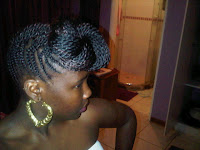 Two weeks ago I paid a visit to a natural hair specialist to have my hair washed and retwisted. I actually forgot to bring my own shampoo and conditioner, but was familiar with the products she used. After I sat under the dryer for a about 30 minutes, she rubbed oil on my scalp. I was happy with my hair when I left the salon.
Two weeks ago I paid a visit to a natural hair specialist to have my hair washed and retwisted. I actually forgot to bring my own shampoo and conditioner, but was familiar with the products she used. After I sat under the dryer for a about 30 minutes, she rubbed oil on my scalp. I was happy with my hair when I left the salon.
About 24 hours later, I was covered in hives.
When I started seeing my stylist, I made mention of the various “natural” products I could not use because of my allergies. Shea butter, lemongrass, and tea tree oil are all on that list. Unfortunately, the oil she used that day had tea tree oil in it. It wasn’t anything benadryl couldn’t handle, but it could have been prevented. I would advise anyone to test out a product before they use it to make sure they’re not allergic to it. In countless hair forums, I’ve seen women complain about rashes, hives, swelling, only to find out it’s an allergic to reaction to their new favorite natural hair product.
Below are a list of common symptoms to a few popular ingredients in natural hair products:
 One common side effect of tea tree oil is skin irritation, especially if applied to broken or dry areas of the skin. Skin irritation can include stinging, burning redness itching or inflammation. In some cases, full strength tea tree oil can also cause mild to severe rashes to develop on the treated skin. Performing a skin patch test is recommended before applying. Tea tree oil can also cause a mild to severe allergic reaction to those who are allergic to the plant. If you are allergic to ingredients from the same family as tea tree oil, such as cloves, guava, eucalyptus, or allspice, you may be at a greater risk for having an allergic reaction to tea tree oil, states the American Cancer Society. The longer tea tree oil is allowed to sit and age, the more it also has a chance to break down into components that are more likely to cause an allergic reaction. Signs of a mild allergic reaction may include hives, rashes, itching, or congestion. More serious allergic reactions can include the same signs as a mild reaction plus possible cramps, diarrhea, light-headedness, flushing, vomiting, swelling, or life-threatening anaphylaxis.
One common side effect of tea tree oil is skin irritation, especially if applied to broken or dry areas of the skin. Skin irritation can include stinging, burning redness itching or inflammation. In some cases, full strength tea tree oil can also cause mild to severe rashes to develop on the treated skin. Performing a skin patch test is recommended before applying. Tea tree oil can also cause a mild to severe allergic reaction to those who are allergic to the plant. If you are allergic to ingredients from the same family as tea tree oil, such as cloves, guava, eucalyptus, or allspice, you may be at a greater risk for having an allergic reaction to tea tree oil, states the American Cancer Society. The longer tea tree oil is allowed to sit and age, the more it also has a chance to break down into components that are more likely to cause an allergic reaction. Signs of a mild allergic reaction may include hives, rashes, itching, or congestion. More serious allergic reactions can include the same signs as a mild reaction plus possible cramps, diarrhea, light-headedness, flushing, vomiting, swelling, or life-threatening anaphylaxis.
The problem is that no one seems to recognize shea butter as an allergen or sensitizing agent. Shea is sourced from the nut of a tree that is closely related to the rubber tree, which yields latex, a common allergen. If you have a latex allergy, you’re likely to become allergic to shea. Ironically, shea butter is heralded as a cure for chapped skin, rashes, chapped lips, eczema and psoriasis, but will actually cause these conditions in one who has become cross-sensitized to it. Unfortunately, I know this all too well from personal experience. It is important to note that latex sensitization (a similar condition to latex allergy) worsens with cumulative exposures to latex and chemically similar products. Individuals who become severely sensitized can progress beyond contact dermatitis, developing many food allergies and even suffering anaphylactic shock upon exposure.
Allergies to coconuts and coconut oil are considered rare. They can take two forms: a food allergy or a contact allergy. A tree nut allergy isn’t necessarily related to a coconut allergy. Chances are higher of developing an allergy to touching things that contain coconut oil than developing an allergy to eating things with coconut oil in them. In both cases, your body is reacting to certain proteins it thinks are harmful. Your immune system responds by releasing an antibody called immunoglobulin E, and it tries to fight off the “dangerous” coconut invaders. When it comes to a food allergy to coconut oil, your likely symptoms are itching, hives, nausea, vomiting, diarrhea, trouble breathing and swelling in your lips and tongue. A contact allergy to coconut oil — which is often found in moisturizers, shampoo and other cosmetics — can result in an itchy rash or blisters that develop within a day or two of touching the allergen.





























